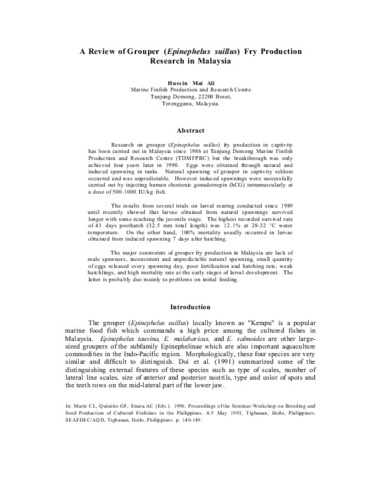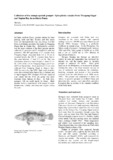A review of grouper (Epinephelus suillus) fry production research in Malaysia
- Global styles
- MLA
- Vancouver
- Elsevier - Harvard
- APA
- Help
Share
抄録
Research on grouper (Epinephelus suillus) fry production in captivity has been carried out in Malaysia since 1986 at Tanjung Demong Marine Finfish Production and Research Centre (TDMFPRC) but the breakthrough was only achieved four years later in 1990. Eggs were obtained through natural and induced spawning in tanks. Natural spawning of grouper in captivity seldom occurred and was unpredictable. However induced spawnings were successfully carried out by injecting human chorionic gonadotropin (hCG) intramuscularly at a dose of 500-1000 IU/kg fish.
The results from several trials on larval rearing conducted since 1989 until recently showed that larvae obtained from natural spawnings survived longer with some reaching the juvenile stage. The highest recorded survival rate of 43 days posthatch (32.5 mm total length) was 12.1% at 28-32 °C water temperature. On the other hand, 100% mortality usually occurred in larvae obtained from induced spawning 7 days after hatching.
The major constraints of grouper fry production in Malaysia are lack of male spawners, inconsistent and unpredictable natural spawning, small quantity of eggs released every spawning day, poor fertilization and hatching rate, weak hatchlings, and high mortality rate at the early stages of larval development. The latter is probably due mainly to problems on initial feeding.
Suggested Citation
Ali, H. M. (1996). A review of grouper (Epinephelus suillus) fry production research in Malaysia. In C. L. Marte, G. F. Quinitio, & A. C. Emata (Eds.), Proceedings of the Seminar-Workshop on Breeding and Seed Production of Cultured Finfishes in the Philippines, Tigbauan, Iloilo, Philippines, 4-5 May 1993 (pp. 140-149). Tigbauan, Iloilo, Philippines: Aquaculture Department, Southeast Asian Fisheries Development Center.
Type
Conference paperISBN
9718511326
Related items
Showing items related by title, author, creator and subject.
-
Philippine National Standard: Live, chilled/frozen grouper
Bureau of Agriculture and Fisheries Standards (Bureau of Agriculture and Fisheries Standards, 2009)This Philippine National Standard for live, chilled/frozen grouper identifies the Philippine species of grouper, specifies their essential composition and quality factors (including size classification and quality ... -
Collection of the orange-spotted grouper Epinephelus coioides from Tinagong Dagat and Sapian Bay in northern Panay
Solis, Noel B. (Bureau of Agricultural Research, Department of Agriculture, 2007)In Capiz, northern Panay, grouper catches by hand picking, hook and line, shelters, and fish corral were low throughout the year, on average 1-3 fish from each fishing operation, but higher in Tinagong Dagat than in Sapian ... -
Assessment of grouper resources around Zamboanga City and Basilan, Philippines
Lasola, N. T.; Samson, R. A.; Domingo, P. B. (Bureau of Agricultural Research, Department of Agriculture, 2007)A total of 2,643 kg of groupers were collected from six markets (96% of the biomass) and from prescribed fish traps in three fishing grounds (106 kg, 4%) around Zamboanga City and Basilan from November 1993 to October 1994. ...







